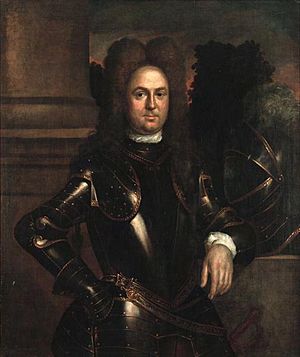Roger Elliott facts for kids
Quick facts for kids
Roger Elliott
|
|
|---|---|
 |
|
| Born | c. 1665 English Tangier, North Africa, or City of London, England |
| Died | 16 May 1714 (aged 49) Byfeld House, Barnes, Surrey, England |
| Buried | |
| Allegiance |
|
| Service/ |
Army |
| Rank | Major-General |
| Battles/wars |
|
| Spouse(s) |
Charlotte Elliot
(m. 1712–1714) |
Roger Elliott (born around 1665 – died May 16, 1714) was an important British military leader. He became one of the first Governors of Gibraltar. His family, the Eliot family, had a strong connection to Gibraltar. His son, Granville Elliott, became a count, and his nephew, George Augustus Eliott, also famously defended Gibraltar later on.
Early Life and Family
Roger Elliott was born around 1665. He might have been born in London, England, but it's more likely he was born in the English colony of Tangier in Morocco. His father, George Elliott, was a surgeon for the soldiers stationed in Tangier. His mother was Catherine Maxwell.
Roger's father passed away in Tangier in 1668. His mother later remarried twice. This made Roger the older half-brother of Alexander Spotswood. Alexander later became a well-known Lieutenant-Governor of Virginia in America.
Military Career
Roger Elliott began his military career early. By 1680, when he was about 15, he was an Ensign (a junior officer) in the Tangier Regiment of Foot. He was wounded in a fight against local groups in Tangier. He also got into trouble for fighting a duel and was sent back to England. However, he was allowed to rejoin the army in 1683.
In 1687, he became a First Lieutenant in the Earl of Bath's Regiment. He was promoted to Captain in 1690. Roger was wounded again while fighting in the Battle of Steenkerque in 1692. He continued to rise through the ranks, becoming a Major and then a Lieutenant-Colonel.
In 1702, while fighting with the famous Duke of Marlborough, Roger was shot during the defense of Tongeren in Belgium. He was known for his bravery, even surrendering only after fighting a much larger French army with just two regiments.
In 1704, he started his own regiment, called Colonel Elliott's Regiment of Foot. He fought and was wounded again at the Battle of Schellenberg in July 1704. It's possible he also fought in the important Battle of Blenheim later that year.
Governor of Gibraltar
In March 1705, Roger Elliott's regiment went to Gibraltar. Gibraltar had become a free port in 1706, meaning ships could trade there without paying taxes. On January 1, 1707, Roger was promoted to Brigadier-General. Later that year, he became the Lieutenant-Governor of Gibraltar.
On December 24, 1707, he was officially made the Governor of Gibraltar. During his time as Governor, he worked hard to improve Gibraltar's defenses. He built important fortifications, even though it was very expensive. He was promoted to Major-General on January 1, 1710. He handed over the governorship to another officer in January 1711 and left Gibraltar in June of that year.
Return to England and Family
After leaving Gibraltar, Roger Elliott returned to England. He leased a house in Barnes, Surrey. He got married and started a family.
On March 4, 1712, Roger married Charlotte Elliot in London. They had two children:
- Granville Elliott (born 1713 – died 1759), who became the first Count Elliott.
- Catherine (Kitty) Elliott (born 1714 – died 1757).
Roger Elliott never fully recovered from the many wounds he received during his military career. He passed away at his home on May 16, 1714. He was buried in the cemetery of St Mary the Virgin, Barnes.


